Alessandro Magnasco: the anticlerical of the eighteenth century
Yes, it is true: the title of this article is deliberately provocative. However, perhaps this is the best way to pay proper tribute to the figure of Alessandro Magnasco (Genoa, 1667 - 1749) who, we make no secret of it, is one of our favorite painters. For if it is excessive to attribute to him truly anticlerical sentiments, at least according to our contemporary perspective, it is on the other hand true that a certain dose (indeed: a high dose) of provocation is inherent in his art. This aspect is what emerges more than any other from the exhibition Alessandro Magnasco. The Maturity Years of a Nonconformist Painter, which can be visited at the Palazzo Bianco Museum in Genoa until June 5, 2016. One of the merits of the exhibition is that it leaves the viewer with the possibility of identifying, in an underlying discourse in which, to be honest, it is rather easy to lose the thread of the skein, a path that runs karstically through the works leaving a glimpse of the Genoese artist’s attitude toward the various declinations to which religion was being subjected by his contemporaries.
And it starts with a clear statement of intent, namely: dissipation and ignorance destroy the arts and sciences. Under this title is known one of his moralizing canvases, as tasty as it is disturbing (and, in some ways, very timely) in which we see a donkey, the immediate symbol of ignorance, and a sow, the allegory of dissipation, ferociously pouncing on easels, books, compasses, and globes (alluding to the arts and sciences), to the utmost dismay of the painter and the scientist, overwhelmed by the fury of the beasts. Similarly overwhelmed is theallegory of Time: the winged old man, defeated, wounded, and humiliated by ignorance, walks away leaning on a pair of crutches and turning one last disconsolate glance toward the wreckage that is unfolding behind him. Further back, a man reveres a donkey seated on a throne, incensing him: a clear (and, still, highly topical) example of how ignorance often rises to power. The mirrors, ubiquitous, provide us with a hint as to who is one of the main perpetrators of the devastation: vanity, further symbolized by the boar admiring itself on the reflective surface, and taking total possession of afrivolous and disengaged aristocracy, gathered around a table and busy wasting time. It is not difficult, to recognize among the figures sitting around the courtesan engaged in doing the honors of the house, a priest lasciviously abandoning himself on the woman’s shoulders, a knight caught up in the revelry and completely oblivious to the sword, which he lets dangle down from his chair, and a jurist too busy observing the card game between the lady of the house and a young damsel to think about his profession.
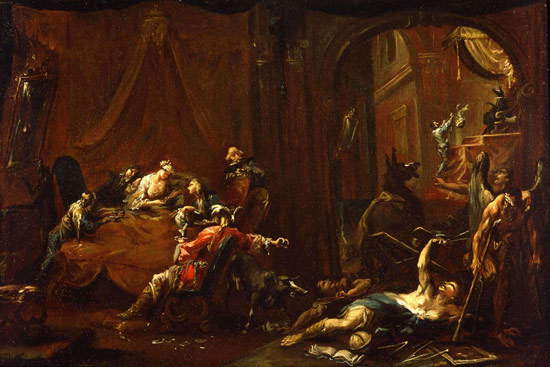 |
| Alessandro Magnasco, Dissipation and Ignorance Destroy the Arts and Sciences (c. 1735-1740; oil on canvas, 62.3 x 91.5 cm; private collection) |
It is precisely in this painting from the second half of the 1730s that we find the unedifying premises that lead us on a brief journey constantly poised between two distant poles, which Alessandro Magnasco describes with his cynical and narrative eye, and with his nimble, quick and often capable of becoming lumpy brushstrokes, which allow him to construct his gloomy figures, extras in a theatrical drama from which they cannot escape. Two distant poles, but united by a single denominator: that of misery, which is aridity and moral misery in the paintings that show convents transformed almost into pleasure residences where futility has blown the place to prayer and recollection, and which is instead material misery in the compositions in which mournful old monks with worn and tattered cassocks try to survive as best they can in a reality made up of hardship, deprivation, and suffering.
A canvas from a private collection, which has been given the eloquent title Scaldatoio, is one of the most illustrative of the harsh living conditions of the monks featured in so many of Alessandro Magnasco’s paintings. A dozen or so monks wrapped in sai now frustrated, thin, hollow-faced sai, many of them beyond their years, gather around an embers, insufficient to warm all of them, so much so that one of them, the one we see in the right foreground, prefers to leave on his crutches, looking sullen and with his mouth open almost as if emitting a grimace of disappointment: despite the quickness of execution typical of the Ligurian painter, we can just imagine him, this old monk, as he strides limply protesting the miserable hint of fire with which the brethren claim to heat a room with a very high ceiling. And while the black smoke rises toward the ruined chimney hood, there are those who blow with the bellows to try to feed the flames, there are those who spread a rag in a vain attempt to dry it, and there are those who simply stretch their hands forward, hooked and angular like those of almost all the protagonists of Magnasco’s paintings, to find from the heat a minimum of comfort: the painter’s narrative ability is among the highest of the entire eighteenth century. And in order to better emphasize the poverty of these friars, Magnasco decides to play the composition almost exclusively on brown and gray tones, the colors that perhaps recur most in this type of production: the references to earth and ash allude significantly and perhaps consciously to the humility of these poor friars.
Humility that also connotes the pilgrims pausing on their way to pray in front of a mountain chapel, immersed in a scenery that reveals to us, if any were needed given that Magnasco’s production abounds with illustrious examples, also the interest the painter nurtured in landscapes, a genre for which he availed himself of the collaboration of a painter from Ancona, Antonio Francesco Peruzzini: the Marche artist realized the landscape, and Magnasco populated it with figures. In the exhibition, moreover, we have a further example of this collaboration in a pair of paintings (the Saint Augustine and the Preaching of Saint Anthony), conceived as pendants, separated by virtue of collectors’ passages, and reunited on the occasion of the exhibition: an interesting opportunity, therefore, to see the two works paired again. Returning to Preghiera davanti a cappella campestre (Prayer in front of a country chapel), it is evident how in this work, preserved precisely in the collections of the Strada Nuova Museums, Magnasco takes care to emphasize how strong is the religious sentiment of those who are undertaking the pilgrimage among these paths: despite the fatigue and hardships of the journey, the pilgrims nevertheless find the energy to gather around the priest with the purpose of reciting a prayer.
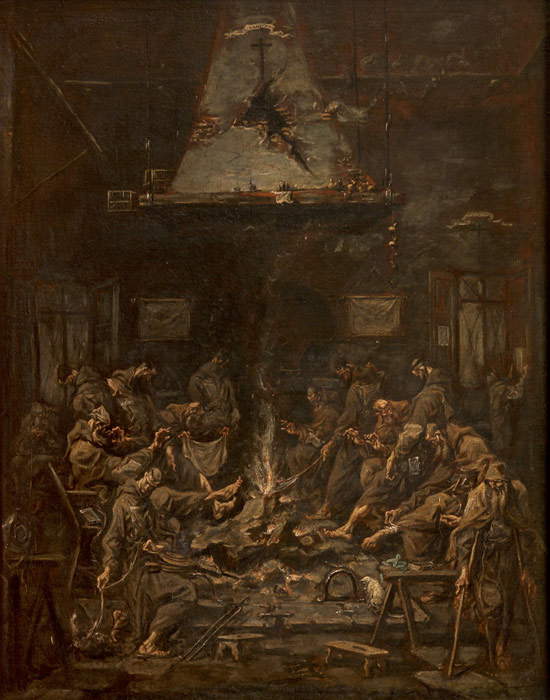 |
| Alessandro Magnasco, Scaldatoio (c. 1720; oil on canvas, 93 x 62 cm; Venice, Lapiccirella Brass Collection) |
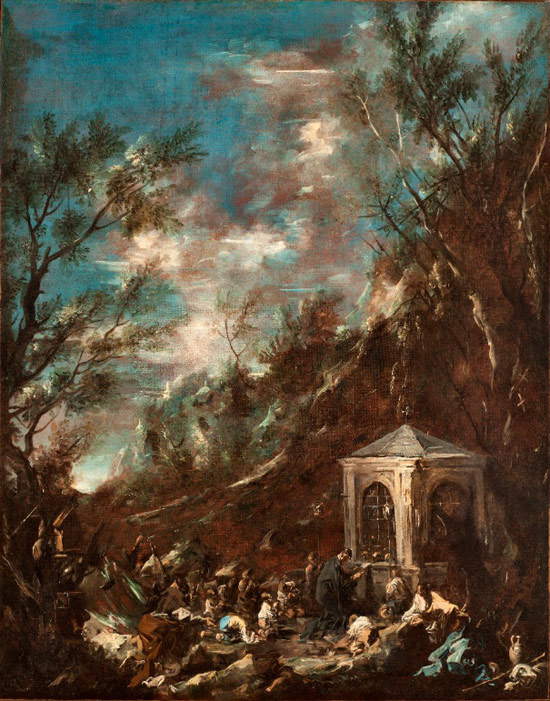 |
| Alessandro Magnasco, Prayer in Front of a Rural Chapel (c. 1717-1719; oil on canvas, 113 x 89; Genoa, Musei di Strada Nuova) |
In these two paintings, as in almost all the fraterie (this is the name by which Magnasco’s monastic-themed paintings are known), there is not the slightest satirical intent. On the contrary: with his fraterie, Magnasco takes a strong stance within a debate around the corruption of monastic orders, which was taking place in the very years in which the painter was making his works. Among the voices that took part in the discussion was that of the Capuchin friar Gaetano Maria da Bergamo (born Marco Migliorini, Bergamo 1672 - 1753), who in 1750, thus a year after Magnasco’s death, published the Istruzioni morali, ascetiche, sopra la povertà de’ frati minori cappuccini, a summation of his ideas as well as the contents of the preaching that the religious had been doing for years in the land of Lombardy, the region in which Magnasco was long active. Gaetano Maria da Bergamo, an ardent and fervent advocate of monastic poverty (some of his advice: to strip oneself of all superfluous possessions, to limit oneself to patching one’s cassocks if they are worn out, to avoid wearing footwear unless strictly necessary, and so on), did not limit himself to suggesting to the friars an ideal of life devoted to evangelical humility, since the target of his heated sermons was also the debauchery of the clergy. We read from one of his sermons, “Even in churches, without respect to the divine majesty, one comes with lust to profane its sanctity. Lust here there is in the thoughts, lust in the looks, lust in the clothes, and in the bows, and in the nods... but I cannot say everything, and from the very not being able to say you may well understand what I would have to say.”
Alessandro Magnasco, with irreverence and provocative charge, in certain of his works almost seems to want to flesh out the words of Gaetano Maria da Bergamo. And if, we repeat, it is difficult to speak of anticlericalism (also because Magnasco’s criticism is moral, rather than political), the artist is not, however, tender toward the laxity of the customs of certain characters pertaining to the circles of the clergy and monasteries. In the painting known as The Chocolate, the Ligurian artist turns his irony against a small group of nuns resting inside what should be their cell, but is in fact a sumptuous interior typical of a stately home: hunger and poverty seem banished from these rooms, within which the nuns dabble with musical instruments (a cello makes a fine display in the foreground, leaning against a piece of furniture) and especially with chocolate, the real star of the painting, which is sipped both by the nun who occupies the center of the composition and is busy swirling the beverage, complete with her little finger firmly raised, and by the novice sitting next to her, richly attired and coiffed like a little lady, caught, moreover, amusing herself with a small dog. And, of course, mirrors abound everywhere. The fact that chocolate plays a starring role serves Alessandro Magnasco’s critique: at the time, the drink was so expensive that it was accessible only to the wealthy classes, who had elevated it to a sort of status symbol. Nothing could be further from the ideal of life that Gaetano Maria da Bergamo recommended for monks.
The poor adherence of monks and nuns is well described in a further canvas, known as Il parlatorio, which depicts the moment when the nuns look out from the grille of the parlatory of their convent to attend a cello concert, improvised by a well-dressed young man whom we see in the foreground, and in which a monk, whom we see from the back, also takes part, and who evidently has some interest in the women beyond the grille: the fact that a man wears a habit certainly does not shield him from the temptations of the flesh. The nuns flock in with visible delight, attracted by the sweetness of the music and huddling on the parapet, in all likelihood not disdaining to cast a few voluptuous glances in regard to the comeliness of the guests.
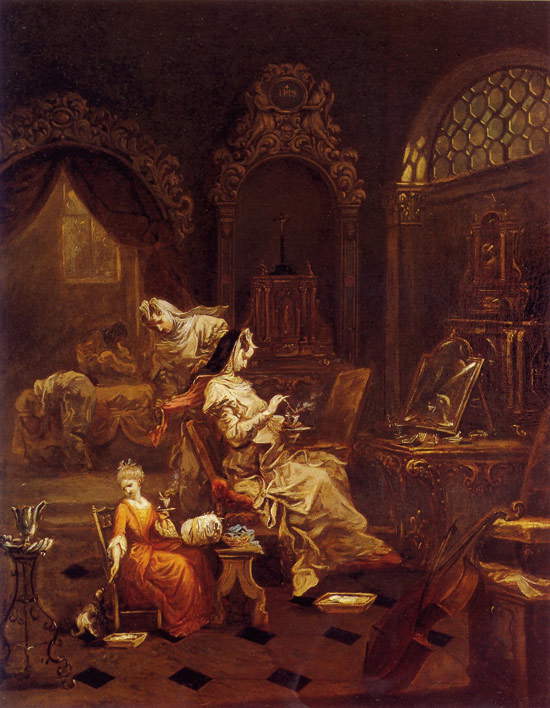 |
| Alessandro Magnasco, The Chocolate (ca. 1740-1745; oil on canvas, 73 x 57 cm; private collection) |
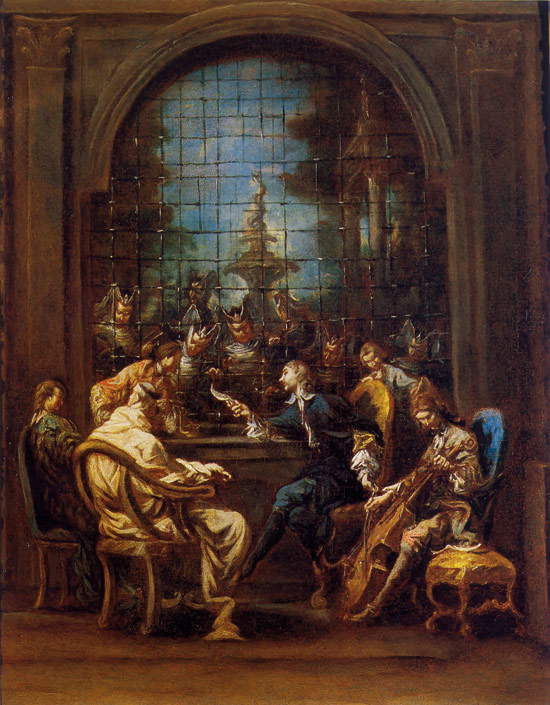 |
| Alessandro Magnasco, Parlatorio (c. 1740-1745; oil on canvas, 85 x 70; private collection) |
In the climate of the nascent Enlightenment, and accustomed to frequenting an educated and increasingly open-minded patronage, Alessandro Magnasco felt the need to propose a committed painting, deliberately anti-academic and non-conformist, taking the side of the last, in open dissent from the higher classes. The Genoese exhibition, despite the flaws it brings with it (the lack of organicity of the layout, which nevertheless holds up, the substantial absence of references to the cultural context within which the artist worked, and the impression of being inside a continuous advertisement of the main promoter of the exhibition, the Galerie Canesso of Paris), nevertheless succeeds in bringing out these aspects of the personality of an artist to whom, because of his extreme modernity and the innovative charge of his painting, some excess of moralism may also be forgiven. It will be worth pointing out, however, that when a major exhibition on this great artist was held in Berlin in 1914, art historian Paolo D’Ancona, in reviewing the exhibition, had this to say: “Magnasco is not a moralist in the true sense of the word [...]. Rather, he is a curious spirit who observes with an indulgent eye and with predilection the life of humble beings, whom he most appreciates because they are closest to nature, and these beings he admirably succeeds in setting in their world, so that the result is a homogeneous whole in which man and nature are inextricably joined.” An apt definition for one of the absolute most difficult artists to frame according to pre-established categories or labels.
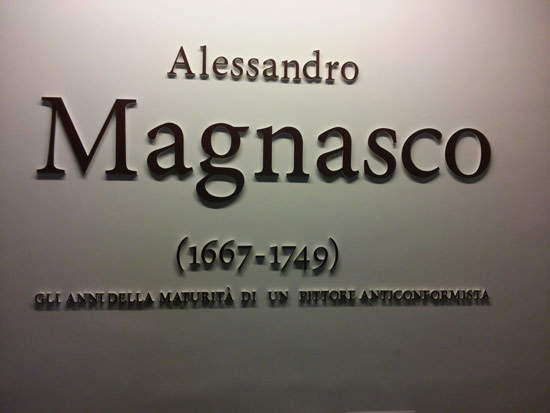 |
| Alessandro Magnasco. The Maturity Years of a Nonconformist Painter. Genoa, Palazzo Bianco, through June 5, 2016 |
Warning: the translation into English of the original Italian article was created using automatic tools. We undertake to review all articles, but we do not guarantee the total absence of inaccuracies in the translation due to the program. You can find the original by clicking on the ITA button. If you find any mistake,please contact us.



























